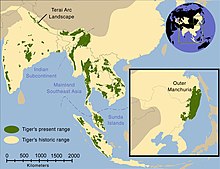Tiger urine
| Tiger Temporal range: early Pleistocene–Present |
|
|---|---|
 |
|
| A Bengal tiger (P. t. tigris) at Kanha National Park, India, Continental Asia | |
| Scientific classification | |
| Kingdom: | Animalia |
| Phylum: | Chordata |
| Class: | Mammalia |
| Order: | Carnivora |
| Suborder: | Feliformia |
| Family: | Felidae |
| Genus: | Panthera |
| Species: | P. tigris |
| Binomial name | |
|
Panthera tigris (Linnaeus, 1758) |
|
| Subspecies | |
|
see text |
|
 |
|
| Tiger's historic range in about 1850 (pale yellow) and in 2006 (in green). | |
| Synonyms | |
|
Tigris striatus Severtzov, 1858 |
|
see text
Tigris striatus Severtzov, 1858
The tiger (Panthera tigris) is the largest cat species, most recognizable for their pattern of dark vertical stripes on reddish-orange fur with a lighter underside. The species is classified in the genus Panthera with the lion, leopard, jaguar, and snow leopard. Tigers are apex predators, primarily preying on ungulates such as deer and bovids. They are territorial and generally solitary but social animals, often requiring large contiguous areas of habitat that support their prey requirements. This, coupled with the fact that they are indigenous to some of the more densely populated places on Earth, has caused significant conflicts with humans.
Tigers once ranged widely across Eurasia, from the Black Sea in the west, to the Indian Ocean in the south, and from Kolyma to Sumatra in the east. Over the past 100 years, they have lost 93% of their historic range, and have been extirpated from Western and Central Asia, from the islands of Java and Bali, and from large areas of Southeast, Southern, and Eastern Asia. Today, they range from the Siberian taiga to open grasslands and tropical mangrove swamps. The remaining six tiger subspecies have been classified as endangered by the International Union for Conservation of Nature (IUCN). Major reasons for population decline include habitat destruction, habitat fragmentation and poaching. The extent of area occupied by tigers is estimated at less than 1,184,911 km2 (457,497 sq mi), a 41% decline from the area estimated in the mid-1990s.
...
Wikipedia

